Analysis of User Pays System in Australian Aged Care
VerifiedAdded on 2022/09/22
|7
|1756
|23
Report
AI Summary
This report examines the user pays system in the Australian aged care sector, focusing on healthcare services for the older population. It explores the types of care available, including home-based, center-based, and specialized treatments, and discusses the role of government funding and user contributions. The report analyzes the negative impacts of user pays, such as financial burdens on taxpayers, and the positive outcomes, including the provision of quality healthcare and respect for the rights of the aged. Furthermore, the report delves into the political and ethical issues associated with user pays, including governance, regulation, and informed consent, as well as the challenges of meeting the complex needs of the growing elderly population. The report concludes by highlighting the importance of addressing these issues to ensure equitable and effective aged care services in Australia.
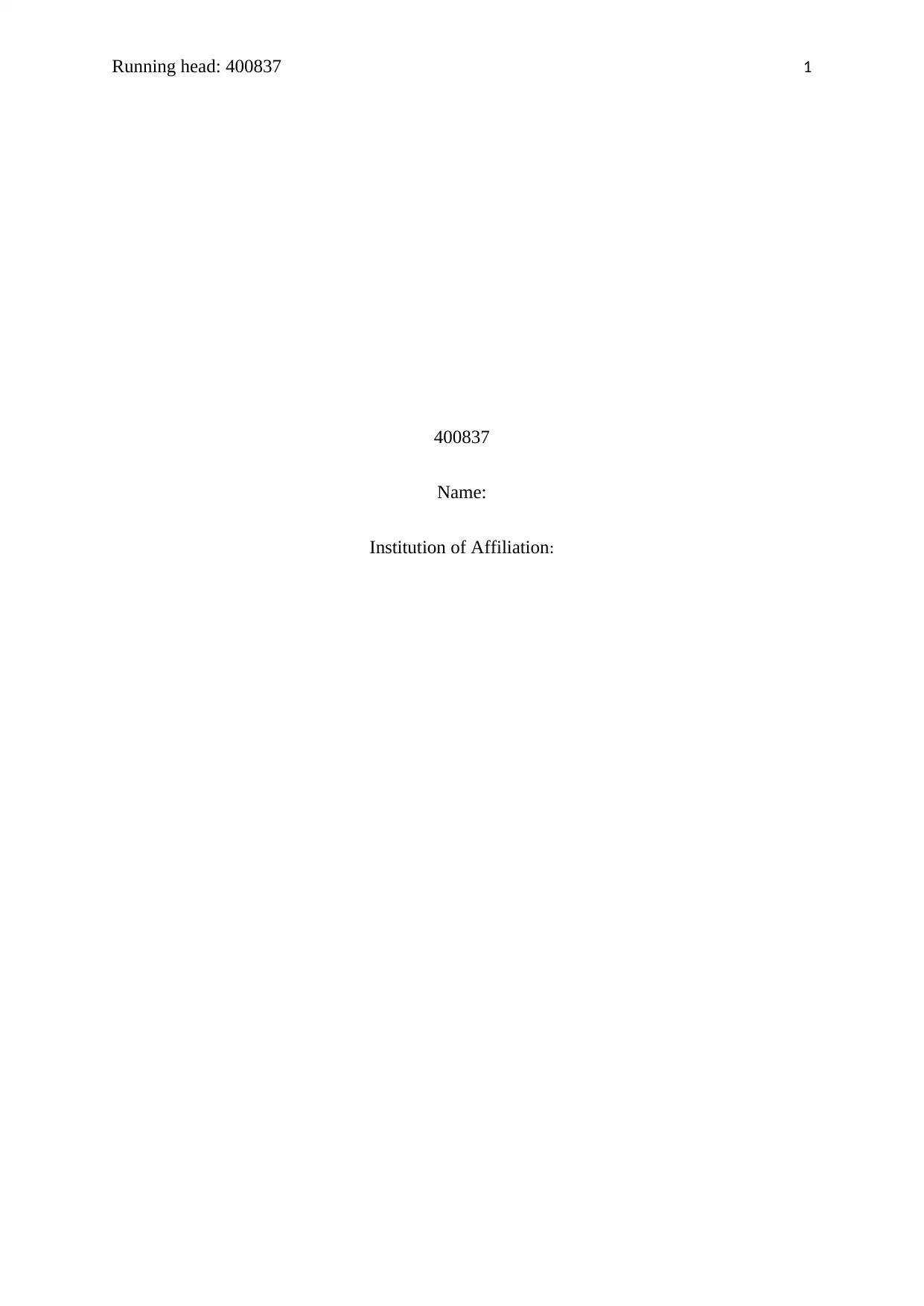
Running head: 400837 1
400837
Name:
Institution of Affiliation:
400837
Name:
Institution of Affiliation:
Paraphrase This Document
Need a fresh take? Get an instant paraphrase of this document with our AI Paraphraser
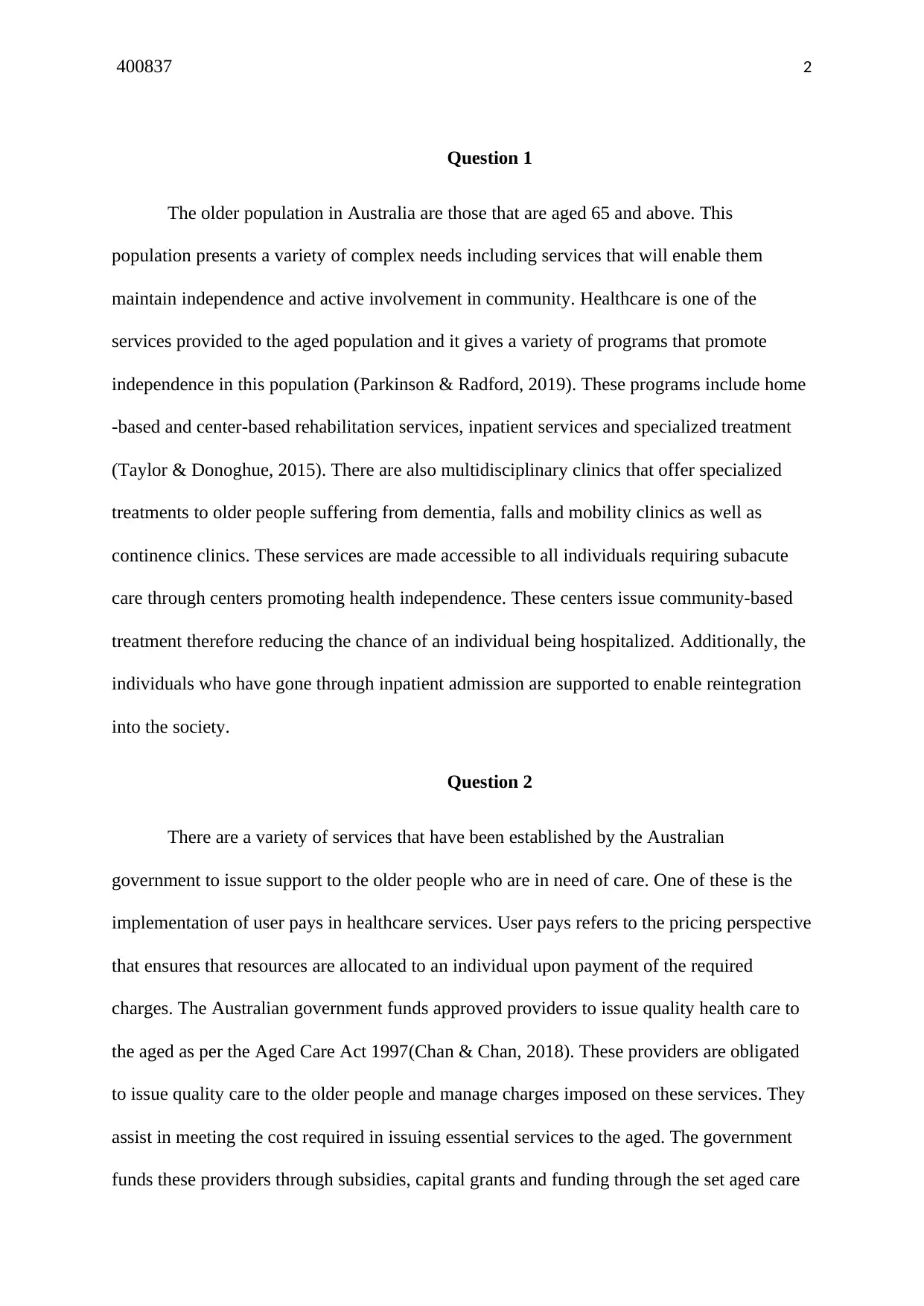
400837 2
Question 1
The older population in Australia are those that are aged 65 and above. This
population presents a variety of complex needs including services that will enable them
maintain independence and active involvement in community. Healthcare is one of the
services provided to the aged population and it gives a variety of programs that promote
independence in this population (Parkinson & Radford, 2019). These programs include home
-based and center-based rehabilitation services, inpatient services and specialized treatment
(Taylor & Donoghue, 2015). There are also multidisciplinary clinics that offer specialized
treatments to older people suffering from dementia, falls and mobility clinics as well as
continence clinics. These services are made accessible to all individuals requiring subacute
care through centers promoting health independence. These centers issue community-based
treatment therefore reducing the chance of an individual being hospitalized. Additionally, the
individuals who have gone through inpatient admission are supported to enable reintegration
into the society.
Question 2
There are a variety of services that have been established by the Australian
government to issue support to the older people who are in need of care. One of these is the
implementation of user pays in healthcare services. User pays refers to the pricing perspective
that ensures that resources are allocated to an individual upon payment of the required
charges. The Australian government funds approved providers to issue quality health care to
the aged as per the Aged Care Act 1997(Chan & Chan, 2018). These providers are obligated
to issue quality care to the older people and manage charges imposed on these services. They
assist in meeting the cost required in issuing essential services to the aged. The government
funds these providers through subsidies, capital grants and funding through the set aged care
Question 1
The older population in Australia are those that are aged 65 and above. This
population presents a variety of complex needs including services that will enable them
maintain independence and active involvement in community. Healthcare is one of the
services provided to the aged population and it gives a variety of programs that promote
independence in this population (Parkinson & Radford, 2019). These programs include home
-based and center-based rehabilitation services, inpatient services and specialized treatment
(Taylor & Donoghue, 2015). There are also multidisciplinary clinics that offer specialized
treatments to older people suffering from dementia, falls and mobility clinics as well as
continence clinics. These services are made accessible to all individuals requiring subacute
care through centers promoting health independence. These centers issue community-based
treatment therefore reducing the chance of an individual being hospitalized. Additionally, the
individuals who have gone through inpatient admission are supported to enable reintegration
into the society.
Question 2
There are a variety of services that have been established by the Australian
government to issue support to the older people who are in need of care. One of these is the
implementation of user pays in healthcare services. User pays refers to the pricing perspective
that ensures that resources are allocated to an individual upon payment of the required
charges. The Australian government funds approved providers to issue quality health care to
the aged as per the Aged Care Act 1997(Chan & Chan, 2018). These providers are obligated
to issue quality care to the older people and manage charges imposed on these services. They
assist in meeting the cost required in issuing essential services to the aged. The government
funds these providers through subsidies, capital grants and funding through the set aged care
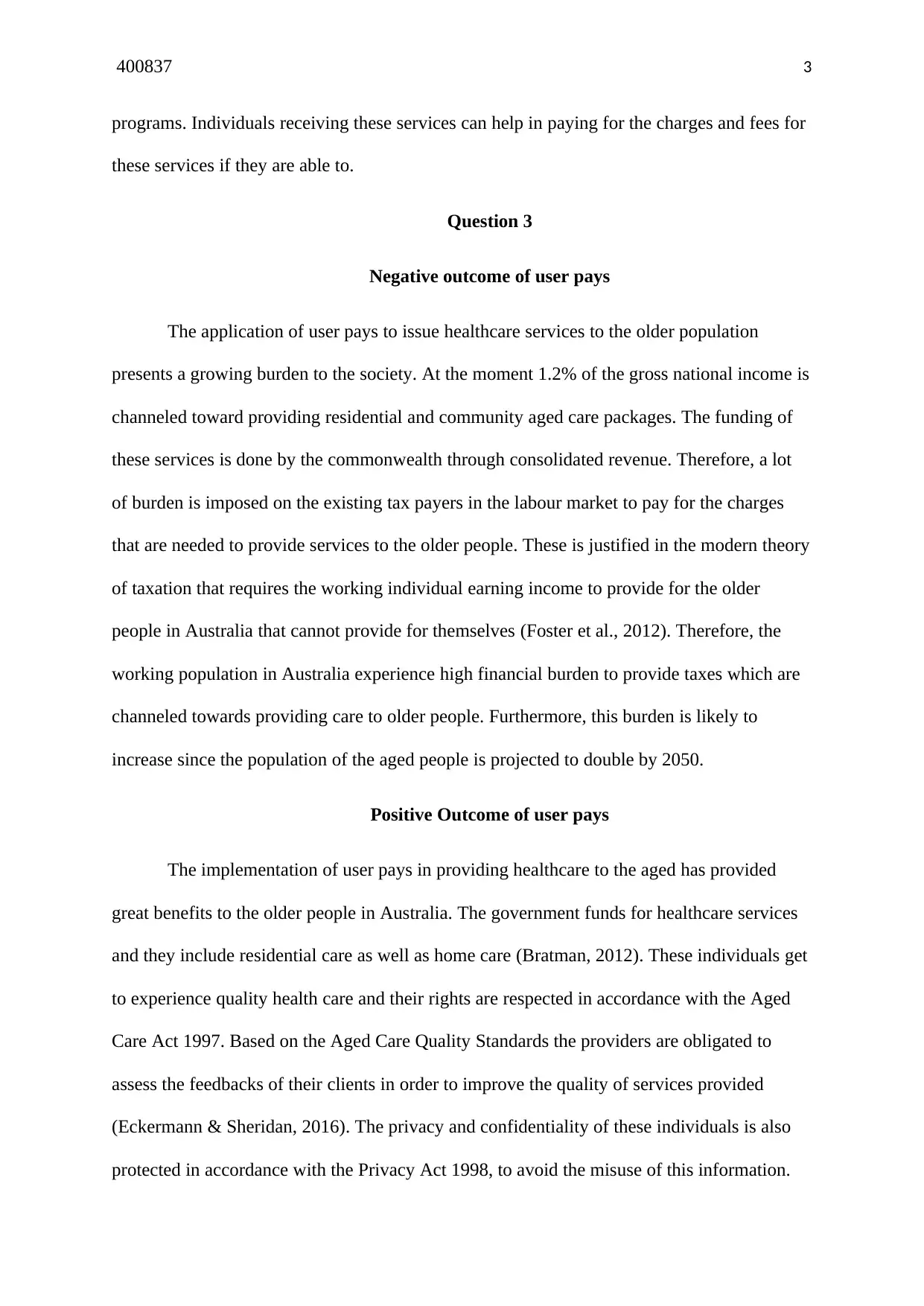
400837 3
programs. Individuals receiving these services can help in paying for the charges and fees for
these services if they are able to.
Question 3
Negative outcome of user pays
The application of user pays to issue healthcare services to the older population
presents a growing burden to the society. At the moment 1.2% of the gross national income is
channeled toward providing residential and community aged care packages. The funding of
these services is done by the commonwealth through consolidated revenue. Therefore, a lot
of burden is imposed on the existing tax payers in the labour market to pay for the charges
that are needed to provide services to the older people. These is justified in the modern theory
of taxation that requires the working individual earning income to provide for the older
people in Australia that cannot provide for themselves (Foster et al., 2012). Therefore, the
working population in Australia experience high financial burden to provide taxes which are
channeled towards providing care to older people. Furthermore, this burden is likely to
increase since the population of the aged people is projected to double by 2050.
Positive Outcome of user pays
The implementation of user pays in providing healthcare to the aged has provided
great benefits to the older people in Australia. The government funds for healthcare services
and they include residential care as well as home care (Bratman, 2012). These individuals get
to experience quality health care and their rights are respected in accordance with the Aged
Care Act 1997. Based on the Aged Care Quality Standards the providers are obligated to
assess the feedbacks of their clients in order to improve the quality of services provided
(Eckermann & Sheridan, 2016). The privacy and confidentiality of these individuals is also
protected in accordance with the Privacy Act 1998, to avoid the misuse of this information.
programs. Individuals receiving these services can help in paying for the charges and fees for
these services if they are able to.
Question 3
Negative outcome of user pays
The application of user pays to issue healthcare services to the older population
presents a growing burden to the society. At the moment 1.2% of the gross national income is
channeled toward providing residential and community aged care packages. The funding of
these services is done by the commonwealth through consolidated revenue. Therefore, a lot
of burden is imposed on the existing tax payers in the labour market to pay for the charges
that are needed to provide services to the older people. These is justified in the modern theory
of taxation that requires the working individual earning income to provide for the older
people in Australia that cannot provide for themselves (Foster et al., 2012). Therefore, the
working population in Australia experience high financial burden to provide taxes which are
channeled towards providing care to older people. Furthermore, this burden is likely to
increase since the population of the aged people is projected to double by 2050.
Positive Outcome of user pays
The implementation of user pays in providing healthcare to the aged has provided
great benefits to the older people in Australia. The government funds for healthcare services
and they include residential care as well as home care (Bratman, 2012). These individuals get
to experience quality health care and their rights are respected in accordance with the Aged
Care Act 1997. Based on the Aged Care Quality Standards the providers are obligated to
assess the feedbacks of their clients in order to improve the quality of services provided
(Eckermann & Sheridan, 2016). The privacy and confidentiality of these individuals is also
protected in accordance with the Privacy Act 1998, to avoid the misuse of this information.
⊘ This is a preview!⊘
Do you want full access?
Subscribe today to unlock all pages.

Trusted by 1+ million students worldwide
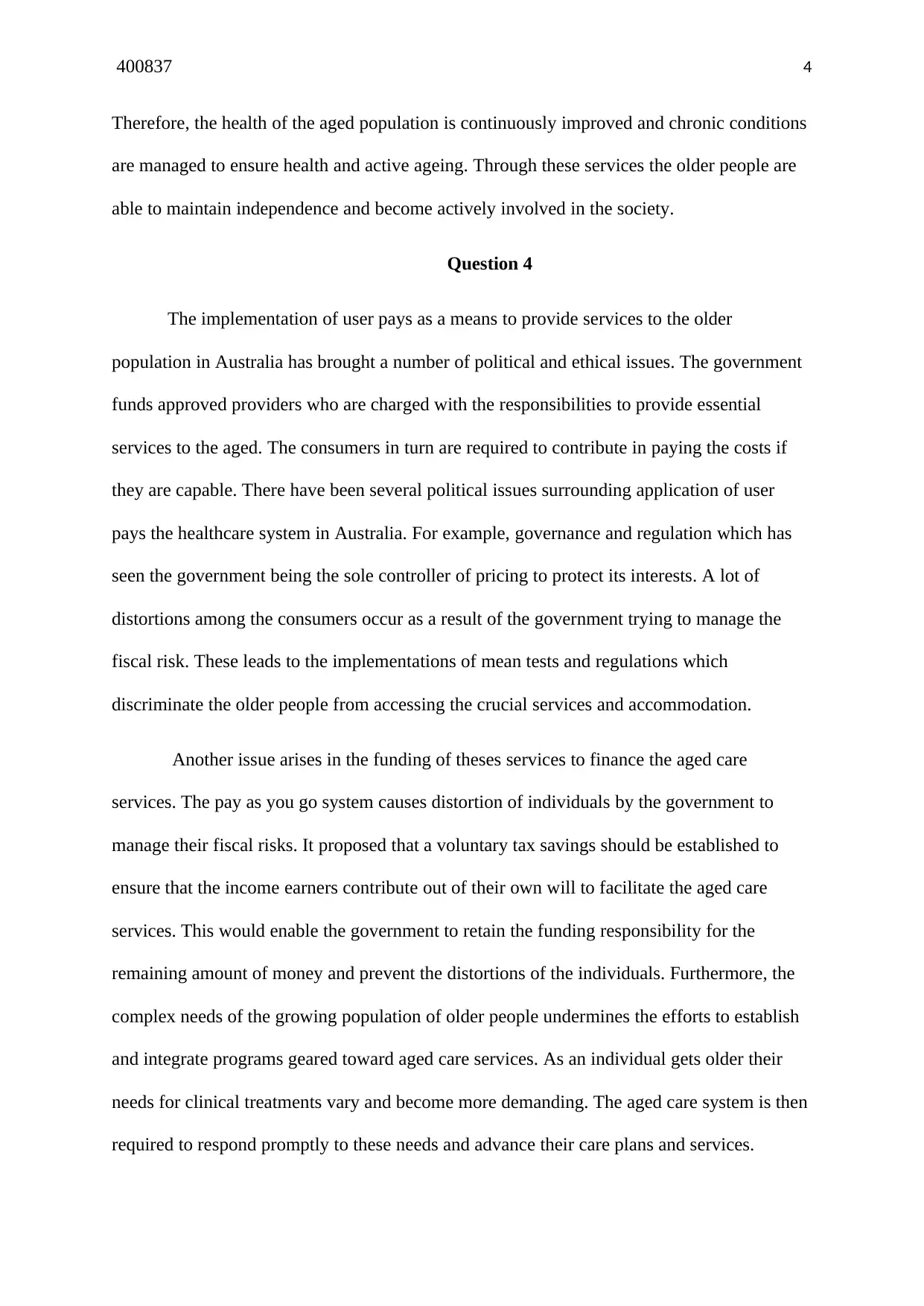
400837 4
Therefore, the health of the aged population is continuously improved and chronic conditions
are managed to ensure health and active ageing. Through these services the older people are
able to maintain independence and become actively involved in the society.
Question 4
The implementation of user pays as a means to provide services to the older
population in Australia has brought a number of political and ethical issues. The government
funds approved providers who are charged with the responsibilities to provide essential
services to the aged. The consumers in turn are required to contribute in paying the costs if
they are capable. There have been several political issues surrounding application of user
pays the healthcare system in Australia. For example, governance and regulation which has
seen the government being the sole controller of pricing to protect its interests. A lot of
distortions among the consumers occur as a result of the government trying to manage the
fiscal risk. These leads to the implementations of mean tests and regulations which
discriminate the older people from accessing the crucial services and accommodation.
Another issue arises in the funding of theses services to finance the aged care
services. The pay as you go system causes distortion of individuals by the government to
manage their fiscal risks. It proposed that a voluntary tax savings should be established to
ensure that the income earners contribute out of their own will to facilitate the aged care
services. This would enable the government to retain the funding responsibility for the
remaining amount of money and prevent the distortions of the individuals. Furthermore, the
complex needs of the growing population of older people undermines the efforts to establish
and integrate programs geared toward aged care services. As an individual gets older their
needs for clinical treatments vary and become more demanding. The aged care system is then
required to respond promptly to these needs and advance their care plans and services.
Therefore, the health of the aged population is continuously improved and chronic conditions
are managed to ensure health and active ageing. Through these services the older people are
able to maintain independence and become actively involved in the society.
Question 4
The implementation of user pays as a means to provide services to the older
population in Australia has brought a number of political and ethical issues. The government
funds approved providers who are charged with the responsibilities to provide essential
services to the aged. The consumers in turn are required to contribute in paying the costs if
they are capable. There have been several political issues surrounding application of user
pays the healthcare system in Australia. For example, governance and regulation which has
seen the government being the sole controller of pricing to protect its interests. A lot of
distortions among the consumers occur as a result of the government trying to manage the
fiscal risk. These leads to the implementations of mean tests and regulations which
discriminate the older people from accessing the crucial services and accommodation.
Another issue arises in the funding of theses services to finance the aged care
services. The pay as you go system causes distortion of individuals by the government to
manage their fiscal risks. It proposed that a voluntary tax savings should be established to
ensure that the income earners contribute out of their own will to facilitate the aged care
services. This would enable the government to retain the funding responsibility for the
remaining amount of money and prevent the distortions of the individuals. Furthermore, the
complex needs of the growing population of older people undermines the efforts to establish
and integrate programs geared toward aged care services. As an individual gets older their
needs for clinical treatments vary and become more demanding. The aged care system is then
required to respond promptly to these needs and advance their care plans and services.
Paraphrase This Document
Need a fresh take? Get an instant paraphrase of this document with our AI Paraphraser
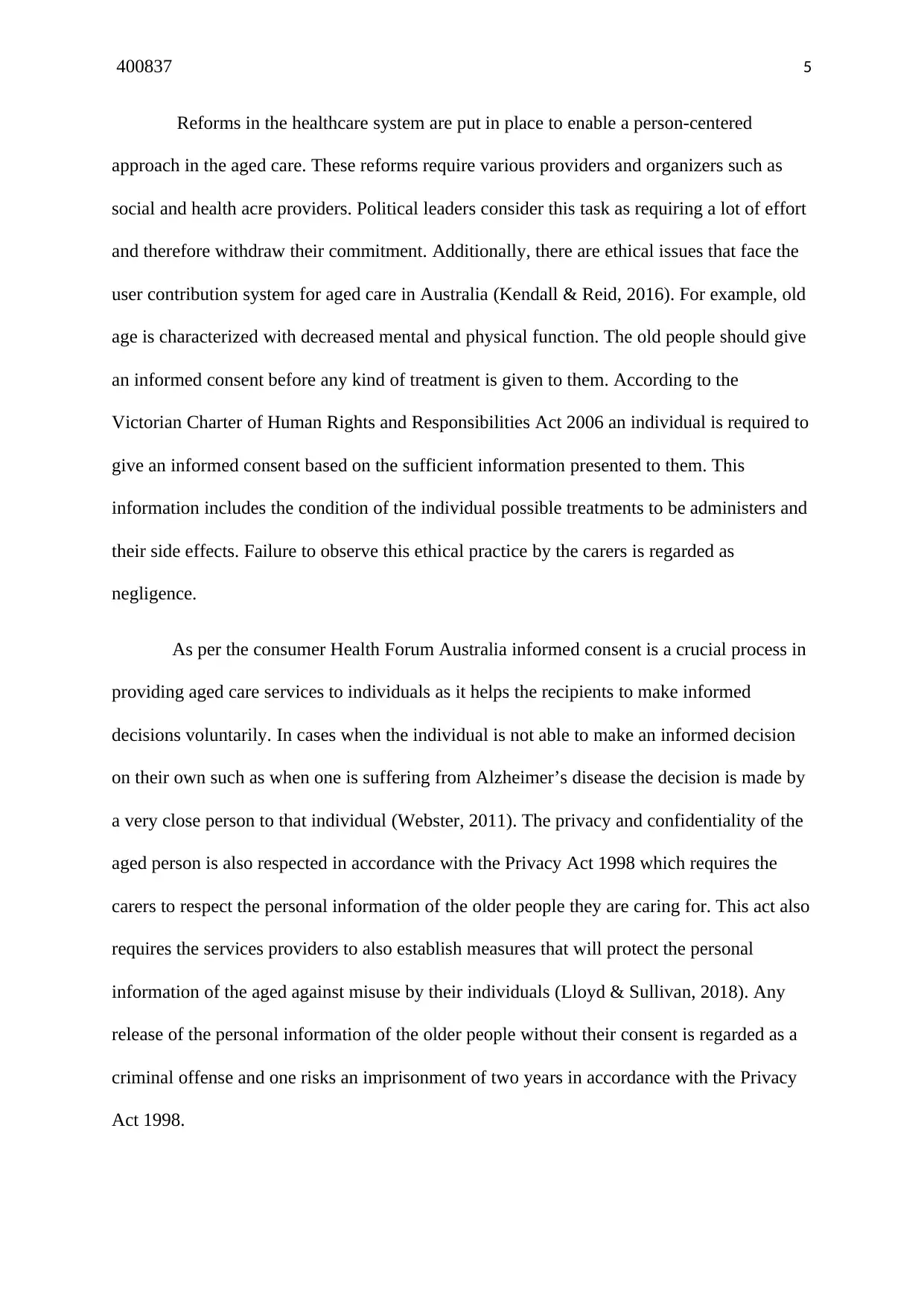
400837 5
Reforms in the healthcare system are put in place to enable a person-centered
approach in the aged care. These reforms require various providers and organizers such as
social and health acre providers. Political leaders consider this task as requiring a lot of effort
and therefore withdraw their commitment. Additionally, there are ethical issues that face the
user contribution system for aged care in Australia (Kendall & Reid, 2016). For example, old
age is characterized with decreased mental and physical function. The old people should give
an informed consent before any kind of treatment is given to them. According to the
Victorian Charter of Human Rights and Responsibilities Act 2006 an individual is required to
give an informed consent based on the sufficient information presented to them. This
information includes the condition of the individual possible treatments to be administers and
their side effects. Failure to observe this ethical practice by the carers is regarded as
negligence.
As per the consumer Health Forum Australia informed consent is a crucial process in
providing aged care services to individuals as it helps the recipients to make informed
decisions voluntarily. In cases when the individual is not able to make an informed decision
on their own such as when one is suffering from Alzheimer’s disease the decision is made by
a very close person to that individual (Webster, 2011). The privacy and confidentiality of the
aged person is also respected in accordance with the Privacy Act 1998 which requires the
carers to respect the personal information of the older people they are caring for. This act also
requires the services providers to also establish measures that will protect the personal
information of the aged against misuse by their individuals (Lloyd & Sullivan, 2018). Any
release of the personal information of the older people without their consent is regarded as a
criminal offense and one risks an imprisonment of two years in accordance with the Privacy
Act 1998.
Reforms in the healthcare system are put in place to enable a person-centered
approach in the aged care. These reforms require various providers and organizers such as
social and health acre providers. Political leaders consider this task as requiring a lot of effort
and therefore withdraw their commitment. Additionally, there are ethical issues that face the
user contribution system for aged care in Australia (Kendall & Reid, 2016). For example, old
age is characterized with decreased mental and physical function. The old people should give
an informed consent before any kind of treatment is given to them. According to the
Victorian Charter of Human Rights and Responsibilities Act 2006 an individual is required to
give an informed consent based on the sufficient information presented to them. This
information includes the condition of the individual possible treatments to be administers and
their side effects. Failure to observe this ethical practice by the carers is regarded as
negligence.
As per the consumer Health Forum Australia informed consent is a crucial process in
providing aged care services to individuals as it helps the recipients to make informed
decisions voluntarily. In cases when the individual is not able to make an informed decision
on their own such as when one is suffering from Alzheimer’s disease the decision is made by
a very close person to that individual (Webster, 2011). The privacy and confidentiality of the
aged person is also respected in accordance with the Privacy Act 1998 which requires the
carers to respect the personal information of the older people they are caring for. This act also
requires the services providers to also establish measures that will protect the personal
information of the aged against misuse by their individuals (Lloyd & Sullivan, 2018). Any
release of the personal information of the older people without their consent is regarded as a
criminal offense and one risks an imprisonment of two years in accordance with the Privacy
Act 1998.
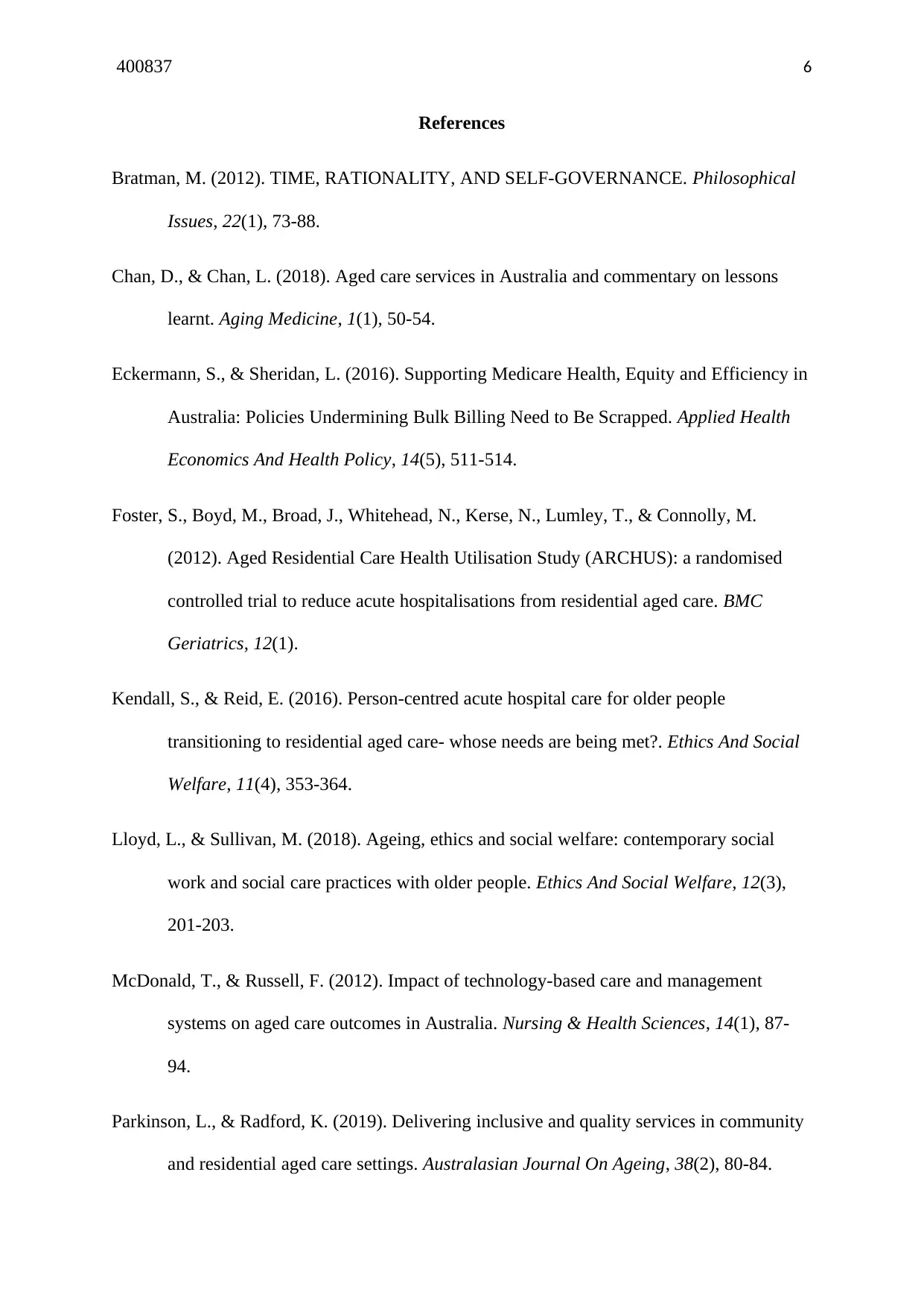
400837 6
References
Bratman, M. (2012). TIME, RATIONALITY, AND SELF-GOVERNANCE. Philosophical
Issues, 22(1), 73-88.
Chan, D., & Chan, L. (2018). Aged care services in Australia and commentary on lessons
learnt. Aging Medicine, 1(1), 50-54.
Eckermann, S., & Sheridan, L. (2016). Supporting Medicare Health, Equity and Efficiency in
Australia: Policies Undermining Bulk Billing Need to Be Scrapped. Applied Health
Economics And Health Policy, 14(5), 511-514.
Foster, S., Boyd, M., Broad, J., Whitehead, N., Kerse, N., Lumley, T., & Connolly, M.
(2012). Aged Residential Care Health Utilisation Study (ARCHUS): a randomised
controlled trial to reduce acute hospitalisations from residential aged care. BMC
Geriatrics, 12(1).
Kendall, S., & Reid, E. (2016). Person-centred acute hospital care for older people
transitioning to residential aged care- whose needs are being met?. Ethics And Social
Welfare, 11(4), 353-364.
Lloyd, L., & Sullivan, M. (2018). Ageing, ethics and social welfare: contemporary social
work and social care practices with older people. Ethics And Social Welfare, 12(3),
201-203.
McDonald, T., & Russell, F. (2012). Impact of technology-based care and management
systems on aged care outcomes in Australia. Nursing & Health Sciences, 14(1), 87-
94.
Parkinson, L., & Radford, K. (2019). Delivering inclusive and quality services in community
and residential aged care settings. Australasian Journal On Ageing, 38(2), 80-84.
References
Bratman, M. (2012). TIME, RATIONALITY, AND SELF-GOVERNANCE. Philosophical
Issues, 22(1), 73-88.
Chan, D., & Chan, L. (2018). Aged care services in Australia and commentary on lessons
learnt. Aging Medicine, 1(1), 50-54.
Eckermann, S., & Sheridan, L. (2016). Supporting Medicare Health, Equity and Efficiency in
Australia: Policies Undermining Bulk Billing Need to Be Scrapped. Applied Health
Economics And Health Policy, 14(5), 511-514.
Foster, S., Boyd, M., Broad, J., Whitehead, N., Kerse, N., Lumley, T., & Connolly, M.
(2012). Aged Residential Care Health Utilisation Study (ARCHUS): a randomised
controlled trial to reduce acute hospitalisations from residential aged care. BMC
Geriatrics, 12(1).
Kendall, S., & Reid, E. (2016). Person-centred acute hospital care for older people
transitioning to residential aged care- whose needs are being met?. Ethics And Social
Welfare, 11(4), 353-364.
Lloyd, L., & Sullivan, M. (2018). Ageing, ethics and social welfare: contemporary social
work and social care practices with older people. Ethics And Social Welfare, 12(3),
201-203.
McDonald, T., & Russell, F. (2012). Impact of technology-based care and management
systems on aged care outcomes in Australia. Nursing & Health Sciences, 14(1), 87-
94.
Parkinson, L., & Radford, K. (2019). Delivering inclusive and quality services in community
and residential aged care settings. Australasian Journal On Ageing, 38(2), 80-84.
⊘ This is a preview!⊘
Do you want full access?
Subscribe today to unlock all pages.

Trusted by 1+ million students worldwide
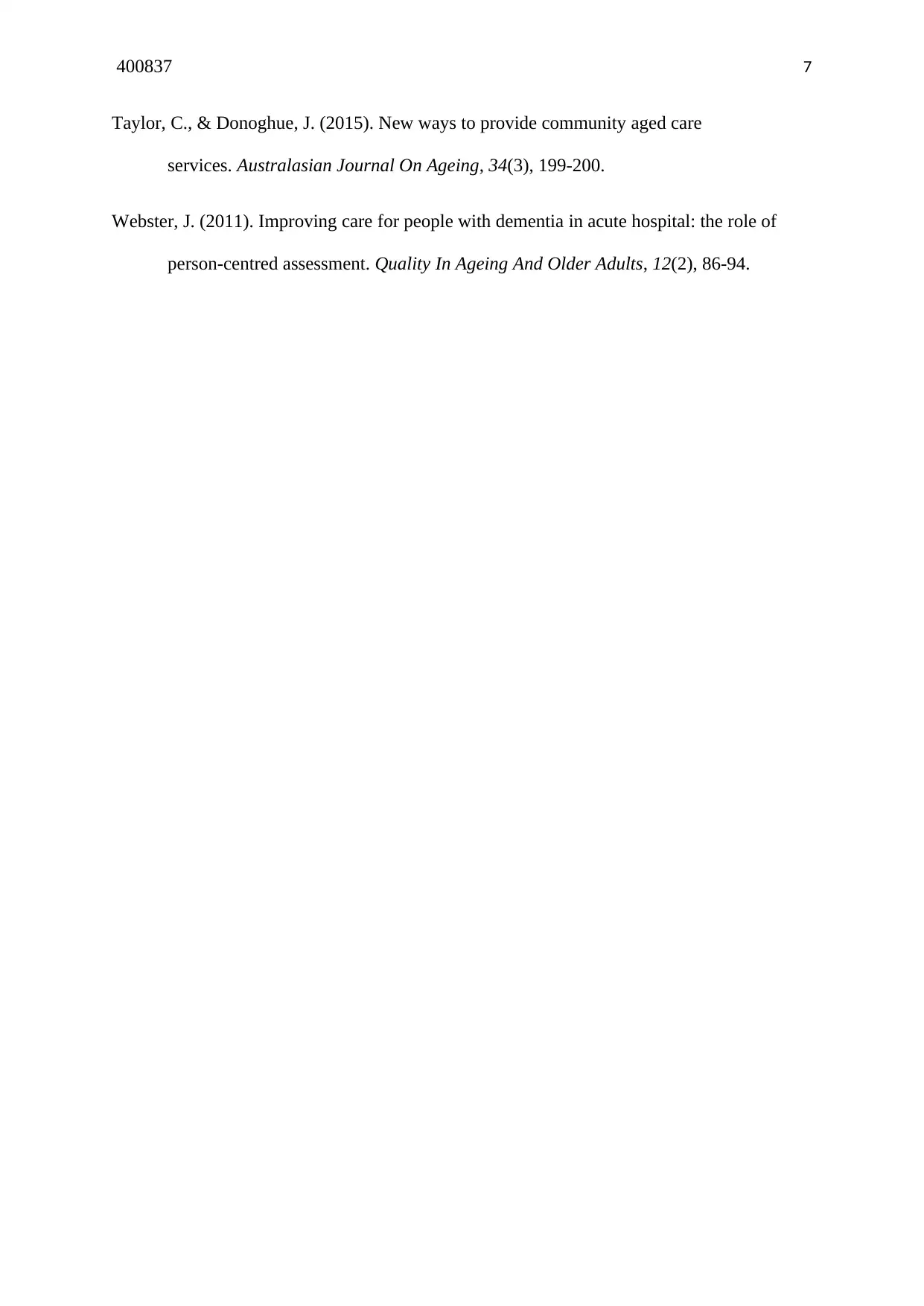
400837 7
Taylor, C., & Donoghue, J. (2015). New ways to provide community aged care
services. Australasian Journal On Ageing, 34(3), 199-200.
Webster, J. (2011). Improving care for people with dementia in acute hospital: the role of
person‐centred assessment. Quality In Ageing And Older Adults, 12(2), 86-94.
Taylor, C., & Donoghue, J. (2015). New ways to provide community aged care
services. Australasian Journal On Ageing, 34(3), 199-200.
Webster, J. (2011). Improving care for people with dementia in acute hospital: the role of
person‐centred assessment. Quality In Ageing And Older Adults, 12(2), 86-94.
1 out of 7
Related Documents
Your All-in-One AI-Powered Toolkit for Academic Success.
+13062052269
info@desklib.com
Available 24*7 on WhatsApp / Email
![[object Object]](/_next/static/media/star-bottom.7253800d.svg)
Unlock your academic potential
Copyright © 2020–2025 A2Z Services. All Rights Reserved. Developed and managed by ZUCOL.





